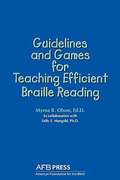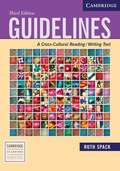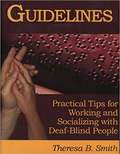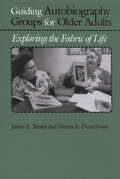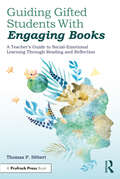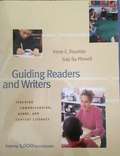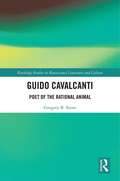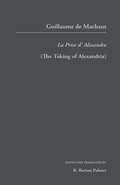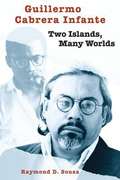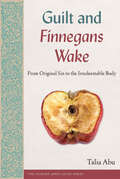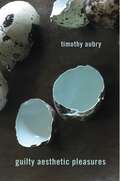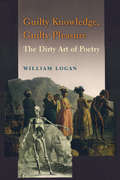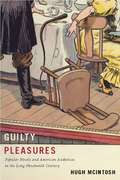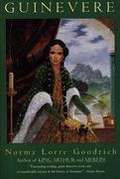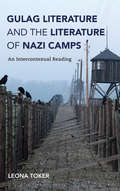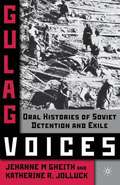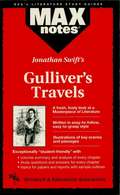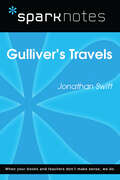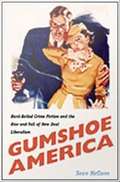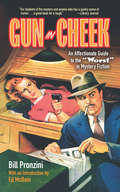- Table View
- List View
Guided Spelling™: Developing Thoughtful Spellers, Grade 4, Blackline Masters
by John Shefelbine Katherine Newman Developmental Studies Center StaffNIMAC-sourced textbook
Guided Spelling™: Developing Thoughtful Spellers, Grade 5, Blackline Masters
by John Shefelbine Katherine Newman Developmental Studies Center StaffNIMAC-sourced textbook
Guidelines and Games for Teaching Efficient Braille Reading
by Sally S. Mangold Myrna R. OlsonThese unique guidelines and games provide ideas for adapting a general reading program to the needs of braille readers and enriching early instruction in braille that are based on research in the areas of rapid reading and precision teaching. Classroom teachers and anyone working with children who are blind or visually impaired will find this classic handbook an invaluable resource.
Guidelines: A Cross-Cultural Reading/Writing Text (Third Edition)
by Ruth SpackAn advanced reading and writing text designed specifically to strengthen students' academic writing. The cross-cultural readings in Guidelines offer a wide range of thought-provoking subject matter, varying in genre, viewpoint, length, and style. As students respond to the readings and work their way through the writing assignments, they are assisted by strategies laid out in 'Guidelines' boxes and by examples from other student writers. Writing assignments include research writing and essays that synthesize sources, critique arguments, and analyze fiction. A handbook is included as a reference guide in the back of the book. It contains sections on documenting sources, drafting and revising, and correcting grammatical errors. Guidelines, Third edition, is a major revision. The readings have been updated, the chapters are easier to navigate, and the 'Guidelines' now include references to the Internet as a means of research.
Guidelines: Practical Tips for Working and Socializing with Deaf-Blind People
by Theresa B. SmithHow does deaf-blindness affect communication? How does one guide a person who is deaf and blind? How does all of this affect the role of the interpreter etc.?
Guiding Autobiography Groups for Older Adults: Exploring the Fabric of Life (Johns Hopkins Ser. In Contemporary Medicine And Public Health Ser.)
by James E. Birren Donna E. Deutchman"Guided autobiography," write the authors, "is ideally suited to foster in the older adult a belief that his or her life is meaningful and something of which to be proud." This book helps professionals—at senior centers, community centers, and other service facilities—guide older adults and others in preparing their autobiographies.Many older adults, the authors explain, have limited social networks. Widowhood, retirement, and other "involuntary transitions" create a loss of roles, which can damage the older adult's sense of identity and self-worth. Guided autobiography can be used very effectively with such persons—to promote their general well- being, develop friendships, and create increased feelings of self-sufficiency.The book's chapters treat such topics as eliciting themes from people's lives, promoting creative thinking, facilitating group interaction, and mastering obstacles in the group process. Based on the authors' fourteen years of experience leading groups in guided autobiography, this book will be of special interest to gerontologists, psychologists, social workers, and other professionals who conduct activity programs for older people.
Guiding Gifted Students With Engaging Books: A Teacher's Guide to Social-Emotional Learning Through Reading and Reflection
by Thomas P. HebertGuiding Gifted Students With Engaging Books supports teachers and counselors in facilitating book discussions designed to guide bright young people to self-understanding through high-quality literature. This exciting resource: Covers social-emotional issues in the lives of gifted students. Features examples of lessons and menus of discussion questions for successful book discussions alongside enrichment activities to extend students' learning. Includes an annotated bibliography of children's and young adult books ideal for social-emotional learning. Engaging lessons and activities support learners as they process their feelings regarding issues highlighted in the selected books and class discussion. The book examines this approach with whole classrooms as well as with small groups of students, and features considerations for special populations of gifted students, including twice-exceptional students, culturally diverse students, and children and teens facing serious adversity in their lives.
Guiding Readers and Writers, Grades 3-6: Teaching Comprehension, Genre, and Content Literacy
by Gay Su Pinnell Irene C. Fountas<p>Authors Irene Fountas and Gay Su Pinnell have already helped hundreds of thousands of K-3 teachers engage, inform, and inspire early readers and writers. Now, with Guiding Readers and Writers (Grades 3-6), Fountas and Pinnell support teachers on the next leg of the literacy journey, addressing the unique challenges of teaching upper elementary students. <p>The product of many years of work with classroom teachers, Guiding Readers and Writers (Grades 3-6)is one of the most comprehensive, authoritative guides available today. It explores all the essential components of a quality literacy program in six separate sections. </p>
Guido Cavalcanti: Poet of the Rational Animal (Routledge Studies in Renaissance Literature and Culture)
by Gregory B. StoneGuido Cavalcanti, Dante’s intellectual mentor, is widely considered among the greatest Italian lyric poets; his famous and notoriously difficult philosophical canzone Donna me prega is often characterized as the most studied lyric poem in Italian literature. This book situates Cavalcanti’s poetry in the context of the Arabic Aristotelian rationalism that entered the Latin West in the 12th century—a tradition marked by questions concerning whether humans can ever transcend their animality. Cavalcanti’s poetry is a focal point where one can view, circa 1300 AD, Arabo-Islamic philosophy in the process of being assimilated and naturalized in Western Europe, eventually leading to values (associated with the Renaissance and the Enlightenment) that we now call modern and secular—in particular, to a notion of human reason as bound up with imagination and with ethical praxis rather than as a means for the attainment of knowledge concerning God and the cosmos. The book features a radically unprecedented interpretation of Donna me prega, starkly opposed to all previous accounts: far from treating love as a threat to reason that would best be eliminated, the canzone praises loving as the essential operation of rational human flourishing. This study of Cavalcanti serves as a prelude to the formulation of a new paradigm for understanding Dante’s Comedy.
Guillaume de Mauchaut: La Prise d'Alixandre (Garland Library of Medieval Literature)
by R. Barton PalmerThis is the first edition in more than a century and the first modern English translation of the crowning masterwork of Machaut's literary career. Based on his extensive discussion with returning crusaders, the poet recounts King Peter I of Cyprus's successful attack and capture of the Egyptian city of Alexandria in 1365. This volume features a full discussion of Machaut's life and career, historical commentary, extensive annotation and a select bibliography.
Guillermo Cabrera Infante: Two Islands, Many Worlds
by Raymond D. SouzaA native Cuban who moved to London in 1966, Guillermo Cabrera Infante is, in every sense, a multilingual and multicultural author. Equally at ease in both Spanish and English, he has distinguished himself with daring and innovative novels, essays, short stories, and film scripts written in both languages. His work has won major literary awards in France, Italy, and Spain, as well as a Guggenheim fellowship in the United States. This biography is the first comprehensive exploration of the life and works of Guillermo Cabrera Infante. Drawing on wide-ranging interviews with the author and his family and friends, as well as extensive study of both published and unpublished works, Raymond D. Souza creates an intimate portrait of Cabrera Infante and the cultural and political milieus that shaped his writing, including Three Trapped Tigers (Tres tristes tigres), View of Dawn in the Tropics (Vista del amanecer en el trópico), Infante's Inferno (La Habana para un Infante difunto), Holy Smoke, A Twentieth Century Job (Un oficio del siglo XX), Writes of Passage (Así en la paz como en la guerra), and Mea Cuba.
Guilt and Finnegans Wake: From Original Sin to the Irredeemable Body (The Florida James Joyce Series)
by Talia AbuExploring the important themes of guilt and morality in James Joyce’s final work James Joyce’s last novel, Finnegans Wake, is notorious for its complex structure and is considered by many to be unreadable. Approaching this complicated book with attention to the theme of guilt, an important concept that has been underexplored in studies of the Wake, Talia Abu presents a clear and thorough interpretation that helps illuminate the book for even the most novice Joyce readers. In Guilt and “Finnegans Wake,” Talia Abu examines how Joyce portrays the evolution of cultural beliefs about morality, from the concept of a moral code set in place by a transcendental authority to an embodied morality that originates in material existence. Through close readings of the novel, Abu demonstrates that Joyce engages with guilt as it relates to the Catholic doctrine of original sin, the institution of the marriage contract, the theories of Nietzsche, and the views of Freud—including Freud’s emphasis on physical experience as the primary aspect of being. Ultimately, Abu argues that Joyce sees guilt as a personal and unique experience and that emotions such as guilt can be reclaimed from the influence of religious and social institutions. Delving into Joyce’s representation of historical events while also analyzing Joyce’s wordplay and linguistic techniques and drawing from multiple disciplines to understand different conceptions of guilt, this book shows the importance of the theme to the form of Finnegans Wake and Joyce’s craft more broadly. Pursuing the questions and ideas that Joyce raises about guilt and morality, Talia Abu makes a case for the enduring relevance of Joyce’s work today. A volume in the Florida James Joyce Series, edited by Sam Slote
Guilty Aesthetic Pleasures
by Timothy AubryFor scholars invested in supporting or challenging dominant ideologies, the beauty of literature seemed frivolous, even complicit with social iniquities. Suspicion of aesthetics became a way to establish the rigor of one’s thought and the purity of one’s politics. Yet aesthetic pleasure never disappeared, Timothy Aubrey writes. It went underground.
Guilty Knowledge, Guilty Pleasure
by William LoganWilliam Logan has been a thorn in the side of American poetry for more than three decades. Though he has been called the "most hated man in American poetry," his witty and articulate reviews have reminded us how muscular good reviewing can be. These new essays and reviews take poetry at its word, often finding in its hardest cases the greatest reasons for hope. Logan begins with a witty polemic against the wish to have critics announce their aesthetics every time they begin a review. "The Unbearable Rightness of Criticism" is a plea to read those critics who got it wrong when they reviewed Lyrical Ballads or Leaves of Grass or The Waste Land. Sometimes, he argues, such critics saw exactly what these books were-they saw the poems plain, yet often did not see that they were poems. In such wrongheaded criticism, readers can recover the ground broken by such groundbreaking books. Logan looks again at the poetry of Wallace Stevens, Frank O'Hara, and Philip Larkin; at the letters of T. S. Eliot, Elizabeth Bishop, and Robert Lowell; and at new books by Louise Glück and Seamus Heaney. Always eager to overturn settled judgments, Logan argues that World War II poets were in the end better than the much-lauded poets of World War I. He revisits the secretly revised edition of Robert Frost's notebooks, showing that the terrible errors ruining the first edition still exist. The most remarkable essay is "Elizabeth Bishop at Summer Camp," which prints for the first time her early adolescent verse, along with the intimate letters written to the first girl she loved.
Guilty Knowledge, Guilty Pleasure: The Dirty Art of Poetry
by William LoganWilliam Logan has been a thorn in the side of American poetry for more than three decades. Though he has been called the "most hated man in American poetry," his witty and articulate reviews have reminded us how muscular good reviewing can be. These new essays and reviews take poetry at its word, often finding in its hardest cases the greatest reasons for hope. Logan begins with a devastating polemic against the wish to have critics announce their aesthetics every time they begin a review. "The Unbearable Rightness of Criticism" is a plea to read those critics who got it wrong when they reviewed Lyrical Ballads or Leaves of Grass or The Waste Land. Sometimes, he argues, such critics saw exactly what these books were—they saw the poems plain yet often did not see that they were poems. In such wrongheaded criticism, readers can recover the ground broken by such groundbreaking books.Logan looks again at the poetry of Wallace Stevens, Frank O'Hara, and Philip Larkin; at the letters of T. S. Eliot, Elizabeth Bishop, and Robert Lowell; and at new books by Louise Glück and Seamus Heaney. Always eager to overturn settled judgments, Logan argues that World War II poets were in the end better than the much-lauded poets of World War I. He revisits the secretly revised edition of Robert Frost's notebooks, showing that the terrible errors ruining the first edition still exist. The most remarkable essay is "Elizabeth Bishop at Summer Camp," which prints for the first time her early adolescent verse along with the intimate letters written to the first girl she loved.
Guilty Pleasures: Popular Novels and American Audiences in the Long Nineteenth Century
by Hugh McIntoshGuilty pleasures in one’s reading habits are nothing new. Late-nineteenth-century American literary culture even championed the idea that popular novels need not be great. Best-selling novels arrived in the public sphere as at once beloved and contested objects, an ambivalence that reflected and informed America’s cultural insecurity. This became a matter of nationhood as well as aesthetics: the amateurism of popular narratives resonated with the discourse of new nationhood.In Guilty Pleasures, Hugh McIntosh examines reactions to best-selling fiction in the United States from 1850 to 1920, including reader response to such best-sellers as Uncle Tom’s Cabin, Ben Hur, and Trilby as well as fictional representations—from Trollope to Baldwin—of American culture’s lack of artistic greatness. Drawing on a transatlantic archive of contemporary criticism, urban display, parody, and advertising, Guilty Pleasures thoroughly documents how the conflicted attitude toward popular novels shaped these ephemeral modes of response. Paying close attention to this material history of novel reading, McIntosh reveals how popular fiction’s unique status as socially saturating and aesthetically questionable inspired public reflection on what it meant to belong to a flawed national community.
Guinevere
by Norma L. Goodrich[from the back cover] "In this, the third in the acclaimed historical series that began with King Arthur and Merlin, Norma Lorre Goodrich, the world's most important living Arthurian expert, clears away centuries of rumor and speculation to deliver a riveting portrait of a woman of dark complexity and endless fascination. For thirteen hundred years Guinevere, King Arthur's queen, has been the focus of legend and rumor. Popular mythology tells of the supposed triangular love affair of Guinevere, Arthur, and Lancelot--yet little is known about the real, historical woman. Now Norma Lorre Goodrich has combed the fields of history, archaeology, linguistics, anthropology, and literature to offer the first complete, historical proof of the existence of this most mysterious queen. The result is a drama far more exciting than anything in our imaginations, and a gripping detective story of history and legend."
Gulag Literature and the Literature of Nazi Camps: An Intercontexual Reading (Jewish Literature And Culture Ser.)
by Leona TokerA literary scholar examines survival narratives from Russian and German concentration camps, shedding new light on testimony in the face of evil. In this illuminating study, Leona Toker demonstrates how Holocaust literature and Gulag literature provide contexts for each other, especially how the prominent features of one shed light on the veiled features and methods of the other. Toker&’s analysis concentrates on the narrative qualities of the works as well as how each text documents the writer&’s experience in a form where fictionalized narrative can double as historical testimony. Toker also views these texts against the background of historical information about the Soviet and the Nazi regimes of repression. Writers at the center of this work include Varlam Shalamov, Primo Levi, Elie Wiesel, and Ka-Tzetnik, and others, including Aleksandr Solzhenitsyn, Evgeniya Ginzburg, and Jorge Semprún, illuminate the discussion. Toker also provides context for references to potentially obscure historical events and shows how they form new meaning in the text.
Gulag Voices
by Jehanne M Gheith Katherine R. JolluckIn this volume, the powerful voices of Gulag survivors become accessible to English-speaking audiences for the first time through oral histories, rather than written memoirs. It brings together interviews with men and women, members of the working class and intelligentsia, people who live in the major cities and those from the "provinces," and from an array of corrective hard labor camps and prisons across the former Soviet Union. Its aims are threefold: 1) to give a sense of the range of the Gulag experience and its consequences for Russian society; 2) to make the Gulag relevant to English-speaking readers by offering comparisons to historical catastrophes they are likely to know more about, such as the Holocaust; and 3) to discuss issues of oral history and memory in the cultural context of Soviet and post-Soviet society.
Gulliver's Travels (MAXNotes Literature Guides)
by Stephen StertzREA's MAXnotes for Jonathan Swift's Gulliver's Travels MAXnotes offer a fresh look at masterpieces of literature, presented in a lively and interesting fashion. Written by literary experts who currently teach the subject, MAXnotes will enhance your understanding and enjoyment of the work. MAXnotes are designed to stimulate independent thought about the literary work by raising various issues and thought-provoking ideas and questions. MAXnotes cover the essentials of what one should know about each work, including an overall summary, character lists, an explanation and discussion of the plot, the work's historical context, illustrations to convey the mood of the work, and a biography of the author. Each chapter is individually summarized and analyzed, and has study questions and answers.
Gulliver's Travels (SparkNotes Literature Guide Series)
by SparkNotesGulliver's Travels (SparkNotes Literature Guide) by Jonathan Swift Making the reading experience fun! Created by Harvard students for students everywhere, SparkNotes is a new breed of study guide: smarter, better, faster.Geared to what today's students need to know, SparkNotes provides:chapter-by-chapter analysis explanations of key themes, motifs, and symbols a review quiz and essay topics Lively and accessible, these guides are perfect for late-night studying and writing papers.
Gum on a Cat
by Barbara W. MakarA systematic, phonics-based early reading program that includes: the most practice for every skill, decodable readers for every skill, and reinforcement materials--help struggling students succeed in the regular classroom
Gumshoe America: Hard-Boiled Crime Fiction and the Rise and Fall of New Deal Liberalism
by Sean MccannIn Gumshoe America Sean McCann offers a bold new account of the hard-boiled crime story and its literary and political significance. Illuminating a previously unnoticed set of concerns at the heart of the fiction, he contends that mid-twentieth-century American crime writers used the genre to confront and wrestle with many of the paradoxes and disappointments of New Deal liberalism. For these authors, the same contradictions inherent in liberal democracy were present within the changing literary marketplace of the mid-twentieth-century United States: the competing claims of the elite versus the popular, the demands of market capitalism versus conceptions of quality, and the individual versus a homogenized society. Gumshoe America traces the way those problems surfaced in hard-boiled crime fiction from the1920s through the 1960s. Beginning by using a forum on the KKK in the pulp magazine Black Mask to describe both the economic and political culture of pulp fiction in the early twenties, McCann locates the origins of the hard-boiled crime story in the genre's conflict with the racist antiliberalism prominent at the time. Turning his focus to Dashiell Hammett's career, McCann shows how Hammett's writings in the late 1920s and early 1930s moved detective fiction away from its founding fables of social compact to the cultural alienation triggered by a burgeoning administrative state. He then examines how Raymond Chandler's fiction, unlike Hammett's, idealized sentimental fraternity, echoing the communitarian appeals of the late New Deal. Two of the first crime writers to publish original fiction in paperback--Jim Thompson and Charles Willeford--are examined next in juxtaposition to the popularity enjoyed by their contemporaries Mickey Spillane and Ross Macdonald. The stories of the former two, claims McCann, portray the decline of the New Deal and the emergence of the rights-based liberalism of the postwar years and reveal new attitudes toward government: individual alienation, frustration with bureaucratic institutions, and dissatisfaction with the growing vision of America as a meritocracy. Before concluding, McCann turns to the work of Chester Himes, who, in producing revolutionary hard-boiled novels, used the genre to explore the changing political significance of race that accompanied the rise of the Civil Rights movement in the late 1950s and the 1960s. Combining a striking reinterpretation of the hard-boiled crime story with a fresh view of the political complications and cultural legacies of the New Deal, Gumshoe America will interest students and fans of the genre, and scholars of American history, culture, and government.
Gun in Cheek: An Affectionate Guide to the "Worst" in Mystery Fiction
by Bill Pronzini Ed McBainWelcome to the very best of the very worst in 20th-century mystery writing. Author Bill Pronzini takes a good-natured look at the genre's "alternative classics" in a retrospective of unintentionally hilarious crime fiction. Populated by the usual private eyes, arch-villains, amateur sleuths, and femmes fatales, these tales offer uniquely amusing reading that's as memorable in its own way as the works of the great mystery writers. In addition to their pure entertainment value, these excerpts and witty appraisals of the "worst" in mystery fiction provide a historical perspective on the development and mores of modern-day crime stories. Featured writers include not only many unsung heroes of pulp fiction but also authors who were popular in their day. Pronzini presents background on the field's subgenres and publishers as well as incisive commentary on the social attitudes reflected by the stories. Advanced and dedicated devotees will appreciate the comprehensive bibliography, which will steer them toward — or away from — these neglected gems.
Guru English: South Asian Religion in a Cosmopolitan Language (Translation/Transnation #12)
by Srinivas AravamudanGuru English is a bold reconceptualization of the scope and meaning of cosmopolitanism, examining the language of South Asian religiosity as it has flourished both inside and outside of its original context for the past two hundred years. The book surveys a specific set of religious vocabularies from South Asia that, Aravamudan argues, launches a different kind of cosmopolitanism into global use. Using "Guru English" as a tagline for the globalizing idiom that has grown up around these religions, Aravamudan traces the diffusion and transformation of South Asian religious discourses as they shuttled between East and West through English-language use. The book demonstrates that cosmopolitanism is not just a secular Western "discourse that results from a disenchantment with religion, but something that can also be refashioned from South Asian religion when these materials are put into dialogue with contemporary social move-ments and literary texts. Aravamudan looks at "religious forms of neoclassicism, nationalism, Romanticism, postmodernism, and nuclear millenarianism, bringing together figures such as Swami Vivekananda, Sri Aurobindo, Mahatma Gandhi, and Deepak Chopra with Rudyard Kipling, James Joyce, Robert Oppenheimer, and Salman Rushdie. Guru English analyzes writers and gurus, literary texts and religious movements, and the political uses of religion alongside the literary expressions of religious teachers, showing the cosmopolitan interconnections between the Indian subcontinent, the British Empire, and the American New Age.

